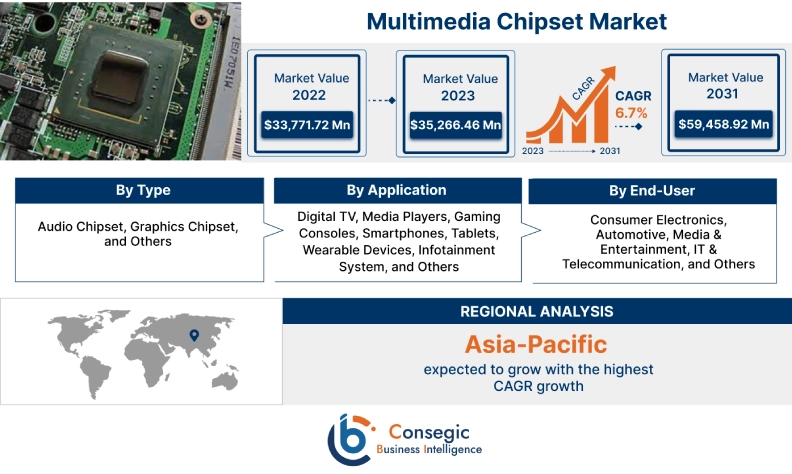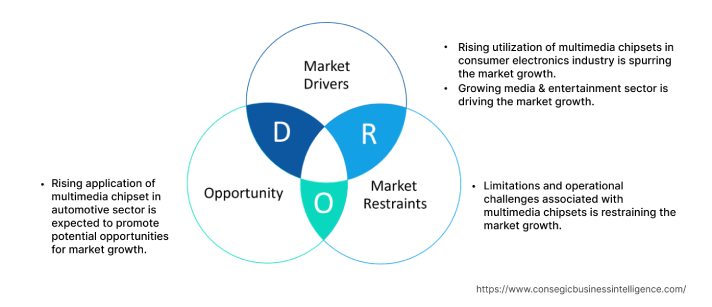- Summary
- Table Of Content
- Methodology
Multimedia Chipset Market Size :
Multimedia Chipset Market is estimated to reach over USD 59,458.92 Million by 2031 from a value of USD 33,771.72 Million in 2022 and is projected to grow by USD 35,266.46 Million in 2023, growing at a CAGR of 6.7% from 2023 to 2031.
Multimedia Chipset Market Scope & Overview:
A multimedia chipset is a set of integrated circuits designed to handle the processing and playback of multimedia content.. Moreover, multimedia chipsets offer a range of benefits including improved system responsiveness, overclocking support, integrated graphics, optimized networking, enhanced multimedia performance, and others. The aforementioned benefits of multimedia chipsets are major determinants for increasing its deployment in consumer electronics, automotive, media & entertainment, IT & telecommunication, and other industries.
Multimedia Chipset Market Insights :
Key Drivers :
Growing media & entertainment sector is driving the market growth
Multimedia chipsets are primarily utilized in media & entertainment sector for applications including high-resolution image editing processes, video rendering, and others that require high network and system performance. Moreover, multimedia chipsets enable efficiency at all stages of media workflows including management, production, processing, delivery, and others which is a primary determinant for driving its utilization in media & entertainment sector.
Factors including the rising investments in the media and entertainment sector, increasing consumer shift towards digital content for entertainment activities, and growing penetration of social media for content distribution are among the major factors driving the growth of the media & entertainment industry.
According to the Motion Picture Association, the global entertainment industry was valued at USD 78.5 billion in 2021, representing a growth of 14% as compared to 2020 and 41% in comparison to 2019. Additionally, according to India Brand Equity Foundation, foreign direct investment in the media and broadcasting sector in India was valued at USD 9.85 billion as of September 2022.
Thus, the growing media and entertainment sector is increasing the adoption of multimedia chipsets for applications including high-resolution image editing processes, video rendering, and others in turn proliferating the market growth.
Rising utilization of multimedia chipsets in consumer electronics industry is spurring the market growth
Multimedia chipsets are utilized in the consumer electronics sector, particularly in applications including smartphones, tablets, laptops, gaming consoles, television, and other related consumer devices. Multimedia chipsets are capable of delivering enhanced audio quality and ultra-high video resolution with faster data transmission, which are vital aspects fostering its integration in consumer electronic devices.
Factors including growing penetration of tablets, smartphones, and other consumer devices, technological advancements including AI (Artificial Intelligence) and IoT (Internet of Things) and rising popularity of wearable devices are primary aspects fostering the growth of the consumer electronics industry.
For instance, according to Atradius, the consumer electronics industry in Spain observed a growth of 3.5% in 2021 in comparison to 2020. Additionally, according to GSM Association, the adoption of smartphones in Asia-Pacific region is projected to reach 83% by 2025, witnessing an incline from 73% in 2021.
Therefore, the growth of consumer electronics sector is driving the integration of multimedia chipsets in smartphones, tablets, television, and other consumer devices, in turn boosting the growth of the market.
Key Restraints :
Limitations and operational challenges associated with multimedia chipsets is restraining the market growth
The implementation of multimedia chipsets is often associated with certain limitations and operational challenges, which are primary factors limiting the market growth.
For instance, multimedia chipsets are usually associated with complex design and higher engineering costs, specifically for chips with high capacity. Moreover, multimedia chipsets have limited flexibility to implement a lot of customizations. Additionally, multimedia chipset comprising of numerous discrete components can cause issues during the latter part of the support stage.
Therefore, the aforementioned limitations and operational challenges related to multimedia chipsets are restraining the growth of the market.
Future Opportunities :
Rising application of multimedia chipset in automotive sector is expected to promote potential opportunities for market growth.
The rising application of multimedia chipsets in automotive sector is expected to present potential opportunities for the growth of the multimedia chipset market. Multimedia chipsets are often used in automotive industry for application in automobile infotainment systems for providing multimedia processing and highly flexible audio/video interface for enhanced driving experience.
Factors including rising automotive production, advancements in autonomous driving, and growing adoption of electric vehicles are driving the growth of the automotive sector.
For instance, according to the European Automobile Manufacturers Association, the production of passenger cars in European Union reached up to 10.9 million in 2022, demonstrating an incline of 8.3% in contrast to 2021. Additionally, according to the International Energy Agency (IEA), the global sales of electric cars observed a substantial growth in 2022. According to IEA, the global sales of electric vehicles reached up to 2 million units during the first quarter of 2022, witnessing a growth of 75% in contrast to the first quarter of 2021.
Hence, the growth of automotive sector is anticipated to increase the utilization of multimedia chipsets for application in automobile infotainment system, in turn promoting opportunities for market growth during the forecast period.
Multimedia Chipset Market Report Insights :
| Report Attributes | Report Details |
| Study Timeline | 2017-2031 |
| Market Size in 2031 | USD 59,458.92 Million |
| CAGR (2023-2031) | 6.7% |
| By Type | Audio Chipset, Graphics Chipset, and Others |
| By Application | Digital TV, Media Players, Gaming Consoles, Smartphones, Tablets, Wearable Devices, Infotainment System, and Others |
| By End-User | Consumer Electronics, Automotive, Media & Entertainment, IT & Telecommunication, and Others |
| By Region | North America, Europe, Asia-Pacific, Latin America, and Middle East & Africa |
| Key Players | Intel Corporation, Advanced Micro Devices Inc., MediaTek Inc., Qualcomm Technologies Inc., NVIDIA Corporation, DSP Group, Broadcom, Samsung, STMicroelectronics, Realtek Semiconductor Corp. |
Multimedia Chipset Market Segmental Analysis :
By Type :
Based on the type, the market is segmented into audio chipset, graphics chipset, and others. The audio chipset segment accounted for the largest revenue share of 47.09% in the year 2022. Audio chipset refers to an integrated circuit designed for producing audio signals through analog, digital, or mixed-mode electronics. Audio chipsets are typically fabricated on metal–oxide–semiconductor mixed-signal chips that process audio signals. Moreover, audio chipset offers a range of features including improved audio clarity, white noise reduction, multiple audio inputs, realistic audio effects, enhanced audio editing, and others. The aforementioned benefits of audio chipsets are driving its utilization in consumer electronics and automotive industries among others.
In October 2023, Qualcomm introduced its new Qualcomm S7 and S7 Pro Gen 1 audio chipsets integrated with active noise cancellation performance. The audio chips are optimized to provide high-performance, low power compute, and advanced connectivity to deliver enhanced audio experience. Thus, rising innovation associated with audio chipsets is among the prime factors driving the growth of the market.
The graphics chipset segment is anticipated to register fastest CAGR growth during the forecast period. A graphics chipset refers to the build of the circuit board that is designed to power a graphics card, which is a device inside a computer that interprets graphics signals from the motherboard. Graphics chipset is responsible for sending visuals to the computer monitor.
In August 2023, Advanced Micro Devices Inc. introduced its new AMD Radeon RX 7800 XT and Radeon RX 7700 XT models of graphics cards that are designed to deliver high-performance and high-refresh gaming experiences. Therefore, the rising advancements related to graphics cards are anticipated to increase the market demand for graphics chipsets, in turn driving the market growth during the forecast period.
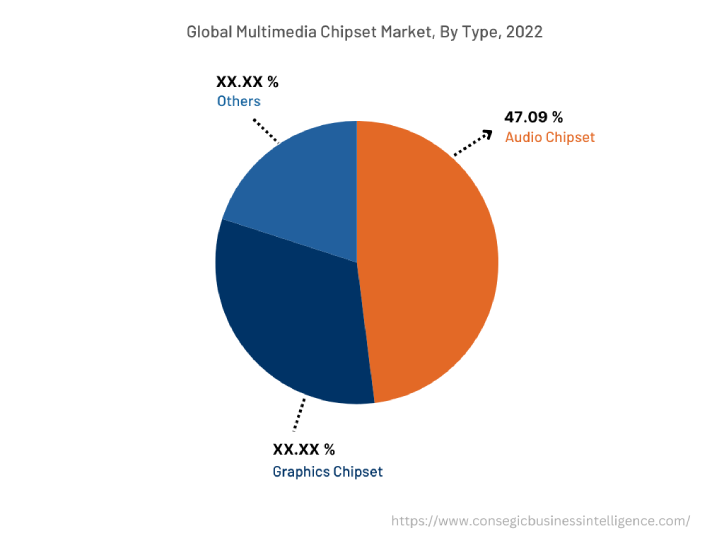
By Application :
Based on the application, the market is segregated into digital TV, media players, gaming consoles, smartphones, tablets, wearable devices, infotainment system, and others. The digital TV segment accounted for the largest revenue share in the year 2022. Multimedia chipsets are primarily used in digital TV to automatically fine-tune picture quality settings for providing enhanced entertainment experiences.
For instance, MediaTek Inc. is a manufacturer of multimedia chipsets that offers a wide range of multimedia chips including MT9638, MT5592, MT5597, and others for application in digital TVs. The chipsets are optimized to provide faster refresh rates and incorporate a suite of advanced features to enhance user experience. Therefore, the increasing innovations associated with multimedia chipsets for application in digital TV is a prime factor proliferating the growth of the market.
The infotainment system segment is anticipated to register fastest CAGR growth during the forecast period. Multimedia chipsets are used in automotive infotainment systems for providing multimedia processing and highly flexible audio/video interface for enhanced driving experience.
For instance, in April 2023, MediaTek announced its plan to introduce Dimensity Auto components for actively engaging in innovative R&D to offer reliable automotive-grade chipsets and components for utilization in automotive cockpit and infotainment system among others. Thus, the increasing advancements related to multimedia chipsets for use in automotive infotainment system is a key factor projected to drive the growth of the segment during the forecast period.
By End-User :
Based on the end-user, the market is segregated into consumer electronics, automotive, media & entertainment, IT & telecommunication, and others. The media & entertainment segment accounted for the largest revenue share in the year 2022. Factors including the rising investments in media and entertainment sector, increasing consumer shift towards digital content for entertainment activities, and growing demand for VOD (video-on-demand) content are among the key prospects driving the growth of the media & entertainment segment.
For instance, according to European Audio-Visual Observatory, VOD (video-on-demand) sector in Europe was valued at USD 13.2 billion in 2020, and its growth was primarily driven by the rapid shift in consumer preference towards content that is accessible at any time, any place, and any device. Thus, the growth of media & entertainment sector is driving the adoption of multimedia chipsets for applications including high-resolution image editing processes, video rendering, and others, in turn proliferating the growth of the market.
Consumer electronics segment is expected to witness fastest CAGR growth during the forecast period. The growth of consumer electronics segment is primarily driven by multiple factors including technological advancements including AI (Artificial Intelligence) and IoT (Internet of Things), growing penetration of tablets, smartphones, and other consumer devices, and rising popularity of wearable devices among others.
For instance, in December 2021, Qualcomm Technologies Inc. launched its Snapdragon G3x Gen 1 chipset that is primarily designed to deliver improved gaming performance on all Android games, stream games from gaming console or PC, and play content from cloud gaming libraries among others. Thus, the rising development of multimedia chipsets for utilization in consumer electronic devices is projected to drive the market growth during the forecast period.
By Region :
The regional segment includes North America, Europe, Asia Pacific, Middle East and Africa, and Latin America.
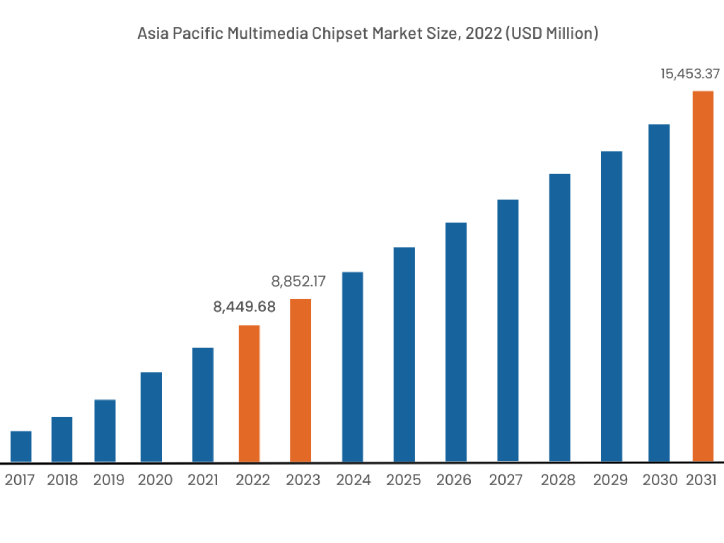
North America is estimated to reach over USD 20,870.08 Million by 2031 from a value of USD 11,759.31 Million in 2022 and is projected to grow by USD 12,288.01 Million in 2023.
The market growth for multimedia chipset in the North American region is mainly driven by its deployment in media & entertainment, automotive, consumer electronics, and other industries. Moreover, the rising deployment of multimedia chipsets in media & entertainment industry to enable improved efficiency at all stages of media workflows including management, production, processing, delivery, and others has been a prevalent factor for market growth in the region.
For instance, according to the Motion Picture Association, the entertainment industry in the United States was valued at USD 32.3 billion in 2021, depicting a growth of 7% in comparison to 2020. The above factors are stimulating the market growth in North America. Furthermore, factors including increasing investments in consumer electronics and automotive sectors are projected to drive the market growth in North America during the forecast period.
Asia-Pacific is expected to grow with the highest CAGR growth of 7.2% and is estimated to reach over USD 15,453.37 Million by 2031 from a value of USD 8,449.68 Million in 2022 and is projected to grow by USD 8,852.17 Million in 2023. In addition, in the region, the China accounted for the maximum revenue share of 35.92%in the same year.
The growing pace of industrialization and development is providing lucrative growth prospects for the market in the region. In addition, factors including the growth of various industries including consumer electronics, IT & telecommunication, media & entertainment, and others are driving the market growth for multimedia chipset in the Asia-Pacific region.
For instance, according to the India Brand Equity Foundation, the consumer electronics sector in India was valued at USD 9.84 billion in 2021, and it is anticipated to grow at a substantial rate to reach USD 21.18 billion by 2025. Multimedia chipsets are usually integrated in consumer electronic devices for delivering enhanced audio quality and ultra-high video resolution with faster data transmission. Hence, the growing consumer electronics sector is driving the application of multimedia chipsets for application in smartphones, tablets, gaming consoles, television, and other related consumer devices, thereby, boosting the market growth in the Asia-Pacific region.
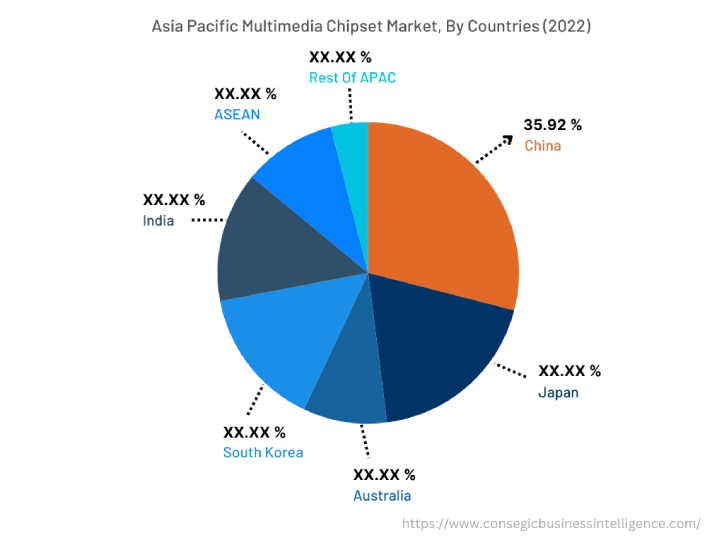
Top Key Players & Market Share Insights:
The multimedia chipset market is highly competitive with major players providing multimedia chipset to the national and international markets. Key players are adopting several strategies in research and development (R&D), product innovation, and end-user launches to hold a strong position in multimedia chipset market. Key players in the multimedia chipset market include-
- Intel Corporation
- Advanced Micro Devices Inc.
- Samsung
- STMicroelectronics
- Realtek Semiconductor Corp.
- MediaTek Inc.
- Qualcomm Technologies Inc.
- NVIDIA Corporation
- DSP Group
- Broadcom
Recent Industry Developments :
- In May 2023, MediaTek Inc. partnered with NVIDIA Corporation for delivering a comprehensive range of in-vehicle AI cabin solutions for the new generation of connected vehicles. The partnership enables MediaTek to develop automotive chipsets integrated with NVIDIA GPU chiplet with NVIDIA graphics IP and AI.
Key Questions Answered in the Report
What is multimedia chipset? +
A multimedia chipset refers to a set of electronic components on one or more integrated circuits and includes components required to run contemporary multimedia applications.
What specific segmentation details are covered in the multimedia chipset report, and how is the dominating segment impacting the market growth? +
For instance, by type segment has witnessed audio chipsets as the dominating segment in the year 2022, owing to the increasing adoption of audio chipset in consumer electronics and automotive industries among others.
What specific segmentation details are covered in the multimedia chipset market report, and how is the fastest segment anticipated to impact the market growth? +
For instance, by end-user segment has witnessed consumer electronics as the fastest-growing segment during the forecast period due to rising adoption of multimedia chipset in consumer devices such as smartphones, tablets, television, gaming consoles, and others.
Which region/country is anticipated to witness the highest CAGR during the forecast period, 2023-2031? +
Asia-Pacific is anticipated to register fastest CAGR growth during the forecast period due to rapid pace of industrialization and growth of multiple industries such as consumer electronics, IT & telecommunication, media & entertainment, and others.
